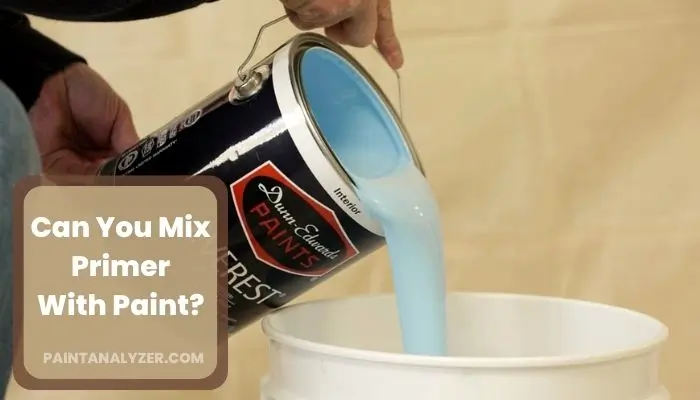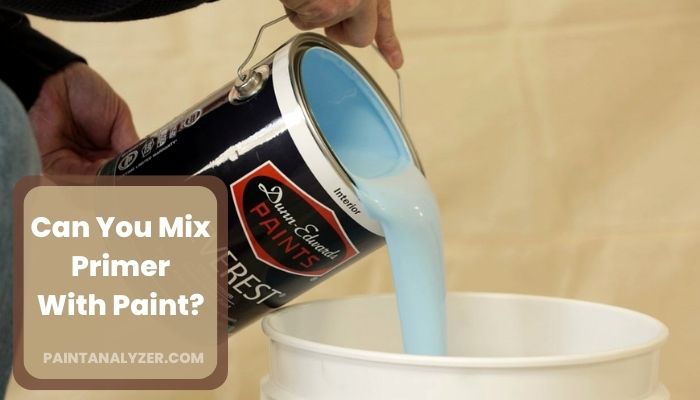The paint job on your walls is a crucial part of your home’s aesthetic appeal. And, if you’re planning on painting any time soon, you’re probably wondering what the best way to go about it is. Can you mix primer with paint?
The answer is a resounding NO! There are a few reasons why you shouldn’t mix primer with paint. Primer is designed to provide a smooth surface for the paint to adhere to and can improve the longevity of your paint job.
Paint is designed to protect the surface it is applied to and provide a decorative finish. Mixing the two together can result in a less-than-ideal finish and may cause the paint to not adhere properly to the surface.

Why you shouldn’t mix Primer With Paint?
When it comes to your home’s paint job, you want to make sure you do everything right in order to achieve the best results. This includes using the proper products and taking the necessary precautions. One mistake that many people make is mixing primer with paint.
While it may seem like a good idea to save time and money by using a product that serves two purposes, it’s actually not recommended. Here’s why:
Paint and primer are formulated differently
Paint and primer are made with different ingredients and are therefore not compatible with each other. When you mix them together, the paint will not adhere to the surface as well as it should. This can lead to peeling and flaking paint over time.
It’s difficult to achieve an even finish
Another reason why you shouldn’t mix paint and primer is that it’s difficult to achieve an even finish. When you use two different products, the paint can end up looking patchy or streaky.
You may not achieve the desired results
When you mix paint and primer, you also run the risk of not achieving the results you desire. The paint may not have the same color or coverage as it would if you used a separate primer. In some cases, you may even find that the paint color is completely different than what you expected.
It’s more expensive
One of the main reasons why you shouldn’t mix primer with paint is because it’s more expensive. You’ll have to purchase two separate products instead of just one, and you may not be happy with the results.
Not necessary
There’s no need to mix primer with paint because you can achieve the same results by using two separate products. In fact, it’s actually recommended that you use a separate primer in order to achieve the best results.
What will happen If You mix Primer with Paint?
When you mix primer with paint, you run the risk of creating a less-than-ideal color match. While primer is designed to help the paint adhere to the surface, it can also alter the paint’s color. If you’re not careful, you could end up with a paint job that looks patchy or uneven. While mixing primer with paint, there are a few potential drawbacks to be aware of.
Changes the paint color
Mixing these two products can impact the final color of your paint job. When you mix primer with paint, it changes the paint color. This is because a primer is a white base that is used to cover up dark colors or prep surfaces for painting. When you add primer to paint, it lightens the paint color.
Changes the paint’s Coverage
The paint may not provide the same level of coverage if it is mixed with primer. Coverage is the measure of how much area a given amount of paint will cover. When the primer is mixed with paint, the coverage will typically be reduced.
This is because the primer is designed to fill in imperfections in the surface that it is being applied to, and the paint is designed to provide a smooth, even finish. If the two are mixed together, the paint’s ability to provide an even finish is reduced.
Paint will not adhere Properly
The paint will not adhere to the surface properly and will not provide the necessary coverage. Paint will also take longer to dry and may chip or peel over time. It is always best to use a separate primer before applying paint to a surface.
How can you Lighten the Color of your paint?
If you want to lighten the color of your paint, there are a few ways to lighten the color of your paint, depending on your needs.
For a temporary need
If you want to lighten the color temporarily, you can add white paint to your light source. This will make the paint appear lighter until the light source is removed.
For Permanent result
To lighten the color permanently, you can add white paint to your paint mixture. This will lighten the color of the paint permanently.
Mix White Paint
One way to lighten the color of your paint is to add white paint to the mix. This will lighten the shade of the paint while also making it opaquer.
Thin the paint using water
Another easy way to lighten paint color is to thin it out with water. This will change the hue of the paint and make it appear lighter.
Use glaze or Varnish
You can use a glaze or varnish to lighten up the color. This will add a transparent layer over the paint that will lighten the color. You can experiment with different shades of glaze or varnish to find the perfect color for your project.
Mixing up the primer- Learn the DIY process
Difference between primer and paint
When it comes to your home’s exterior, you want to make sure it’s well-protected against the elements. To do this, you need to use both primer and paint. But what’s the difference between the two?
There is a big difference between primer and paint, and it is important to understand the difference before beginning any painting project.
What is Primer?
A primer is a preparatory product that is applied to a surface before painting. It helps to create a smooth surface and provides a good foundation for the paint to adhere to. Primer also helps to prepare the surface for painting, and can also improve the final appearance of the paint job.
Primers are available in a variety of formulas, including water-based, oil-based, and shellac-based.
What is paint?
Paint is a type of coating that is applied to a surface to protect it or to change its appearance. There are many different types of paint, each with its own properties and uses. For instance, some paints are designed for use on walls, while others are better suited for use on metal surfaces.
Some paints are also specifically designed for use in certain environments, such as those that are resistant to high temperatures or those that are designed to resist fading in direct sunlight.
Is it possible to mix Primer With Water?
It is possible to mix primer with water, but it is not recommended. The primer is designed to be used with paint, not water. Adding water to the primer can thin it out and make it less effective. It can also cause the primer to bubble and blister, making it difficult to apply evenly to surfaces. If you must mix primer with water, be sure to do so carefully and only add a small amount of water at a time.
If you want to mix primer with water anyway, there are a few things you should keep in mind before doing so.
First and foremost, when diluting primer with water, you will need to use a ratio of 1 part primer to 1 part water. So, for example, if you are using 1 gallon of primer, you would mix in 1 gallon of water as well.
It is important to note that mixing primer with water will affect its drying time. When diluted in this way, a primer will take longer to dry than if it were used on a wall or surface directly without thinning it.
Can You Use Oil-Based Primer With Acrylic Paint?
Yes, you can use an oil-based primer with acrylic paint. However, you need to be aware of a few things before using this combination.
Longer Drying Time
The oil-based primer will take longer to dry than a water-based primer. You’ll need to give it at least 24 hours to fully cure before painting it with acrylic paint.
The paint will not Stick Very well
The acrylic paint may not adhere as well to an oil-based primer, so you may need to use a bonding agent to help it stick.
Clean properly before painting
Make sure you clean up any oil-based primer residue thoroughly before painting over it with acrylic paint, as the paint may not adhere properly if there’s any primer left on the surface.
Is it Safe to Mix Different Types of Paint Together?
Mixing paint finishes: what works? Mixing different types of paint finishes can lead to unpredictable results. While some finishes may blend well together, others may cause bubbling, peeling, or uneven coverage. It’s generally safer to stick to one type of finish for a consistent and professional-looking result.
Conclusion
Primer and paint have different properties. Primer is more of a surface coating to protect the underlying paint. A good quality primer will make the surface of the paint more weather resistant and better adhesion. Paint is a color coating, not a surface coating.
Primer is useful in painting bare or previously painted surfaces which need an extra layer of protection. It is a paint sealer, so it’s not designed to be used with paint by mixing it all together. Primer can block paint from drying properly and can cause issues with coverage.
They can blend in paint, making it more difficult to get an even coat. Lastly, they will also create a barrier, which can prevent paint from adhering to the surface.

